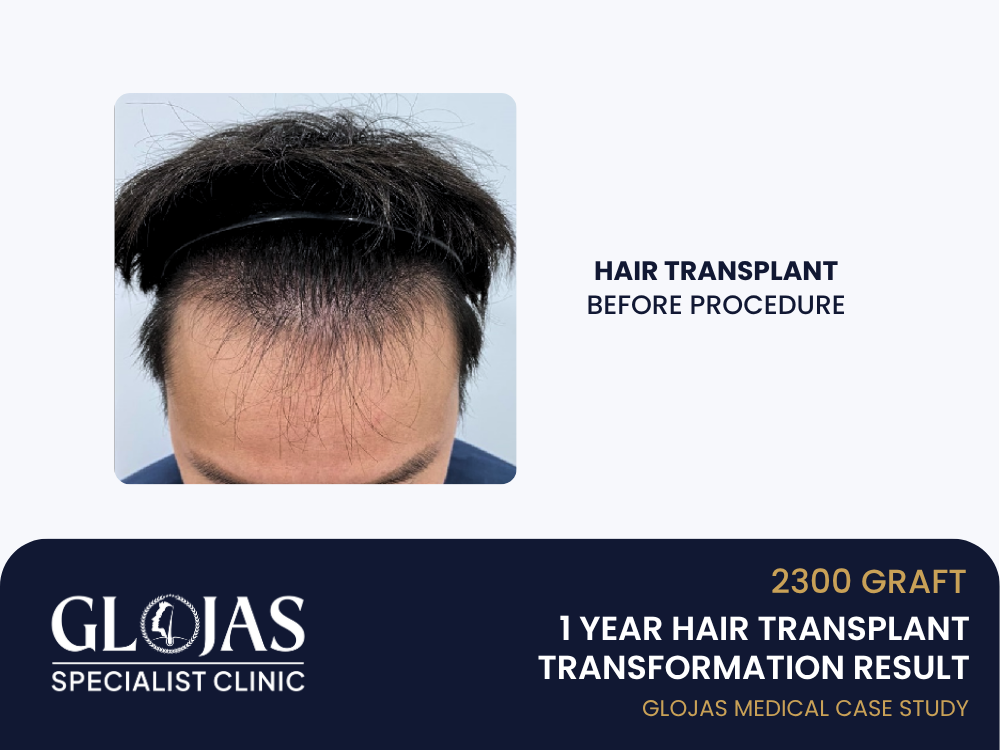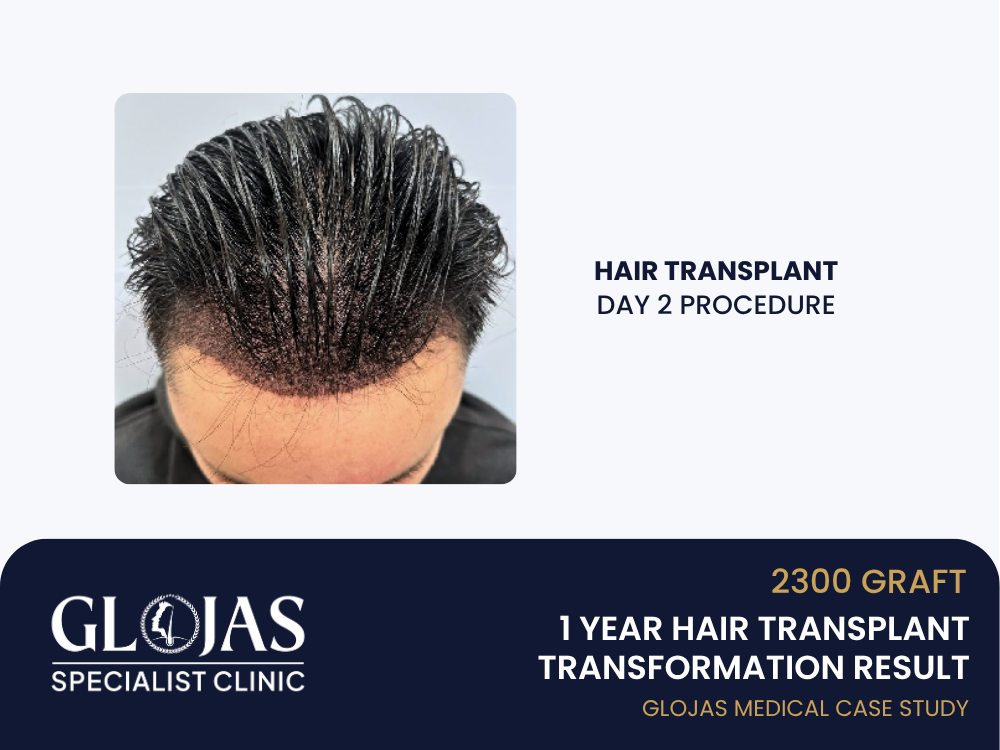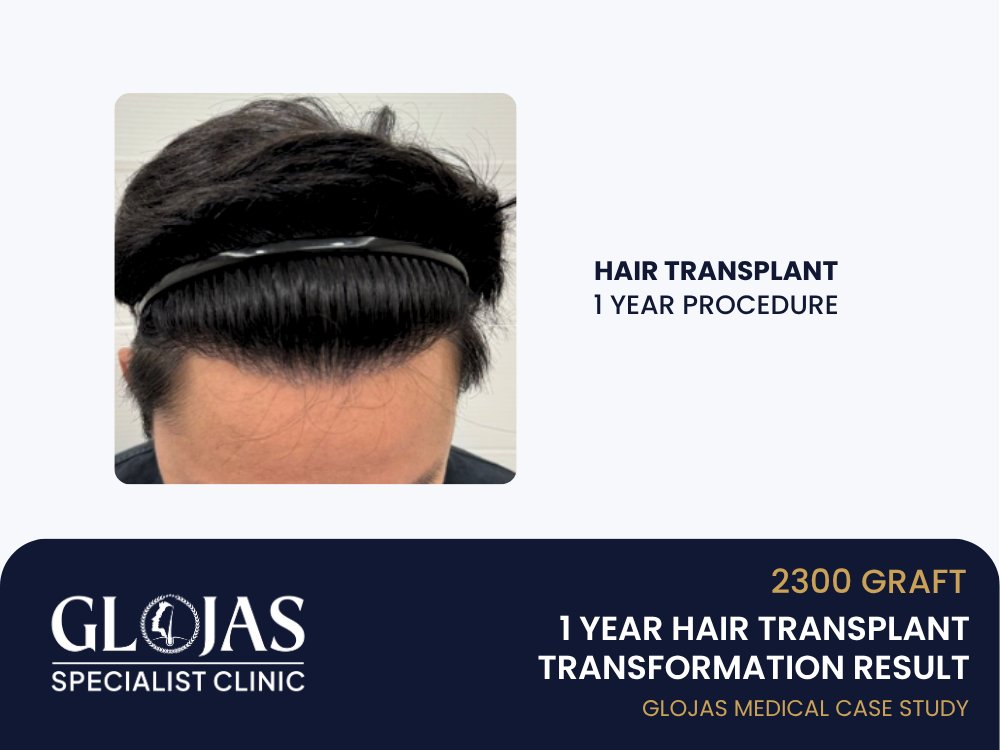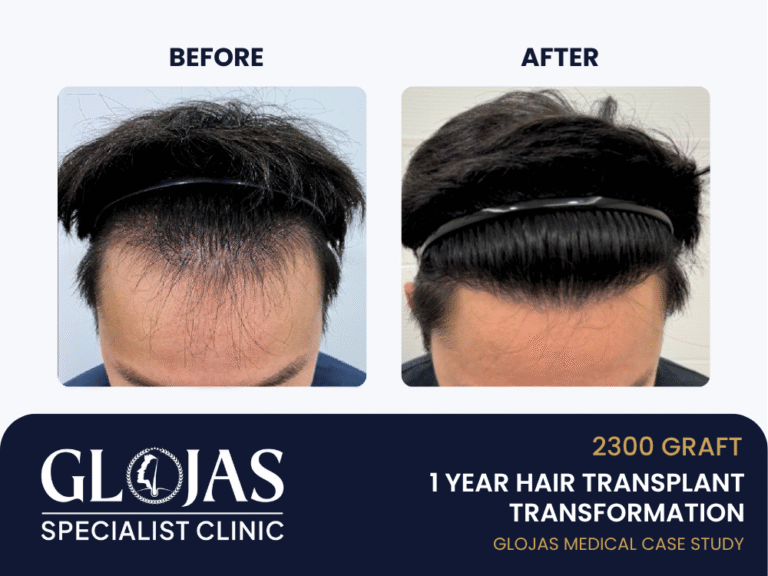Hairline recession is one of the earliest and most noticeable signs of male pattern baldness. Even minor hairline loss can significantly affect one’s appearance and self-esteem. In this case, we follow a 35-year-old male who underwent a SMART™ FUE hair transplant to correct his receding hairline using 2,300 grafts.
After 1 year, he achieved a youthful, natural-looking hairline that enhanced his facial proportions and improved his overall confidence.
Patient Profile
Age: 35
Concern: Receding hairline (Norwood 2–3)
Hair Type: Medium-thick, straight, black
Donor Area: Strong occipital and parietal zones
Goal: Restore a symmetrical, age-appropriate hairline with subtle temple closure
Pre-Procedure Concerns
The patient had noticed a gradual temporal recession over the past 5 years. While his crown and mid-scalp remained unaffected, the M-shaped hairline created an aged and tired look. He was particularly concerned about:
Uneven hairline
Limited styling options
Wider forehead appearance
He wanted a natural restoration that wouldn’t look artificial or “done.”
Why SMART™ FUE?
The SMART™ FUE (Scalp Micro-Advanced Restoration Technique) combines the benefits of traditional FUE with enhanced precision and graft survival rate.
Key Advantages:
Micro punch extraction (0.7–0.8 mm)
High-density graft implantation
Natural angling and direction for realistic regrowth
Minimal downtime and scarring
Ideal for hairline and temple work
This made it the ideal solution for restoring the frontal zone and refining the hairline in a conservative, strategic way.
Consultation & Planning – Hair Transplant
During the consultation, the specialist:
Performed a scalp assessment and trichoscopy
Evaluated donor capacity
Designed a personalized hairline based on the patient’s facial anatomy, age, and aesthetic preference
Hairline Design Goals:
Lower the hairline by ~1.5 cm
Create soft, irregular edges to avoid a “straight line” look
Restore temple points subtly for a fuller, rounded shape
Ensure a natural transition from native to transplanted hair
Procedure Overview

Technique: SMART™ FUE
Grafts Extracted: 2,300
Implanted Areas: Frontal hairline and bilateral temples
Duration: Approx. 6.5 hours
Anesthesia: Local
Implantation Tool: Implanter pens for control and density
Steps:
The donor area was shaved and anesthetized
Grafts harvested manually with a micro punch
Grafts sorted by size and hair count
Recipient sites created at 30–45° angles
Grafts are implanted with attention to hair curl and direction
The patient went home on the same day with thorough post-operative instructions.
Recovery Timeline

| Day/Week | Progress |
|---|---|
| Day 1–3 | Mild swelling, redness, no major discomfort |
| Day 4–7 | Scabbing forms and starts to fall off |
| Week 2–4 | Temporary shedding of implanted hairs (“shock loss”) |
| Month 3 | The initial regrowth phase begins |
| Month 6 | ~60–70% growth visible |
| Month 12 | Full result achieved, with matured hair texture and coverage |
1-Year Results

After 12 months, the patient achieved a natural, even, and dense hairline that blended seamlessly with his existing hair. He was able to style his hair freely, even opting for swept-back looks — something he had avoided previously.
| Before | After (1 Year) |
|---|---|
| Receding “M” pattern hairline | Straightened and softened hairline curve |
| Noticeable temple thinning | Full temples, natural edge transitions |
| Avoided short hairstyles | Confident with open hairstyles |
| Aged appearance, tired look | More youthful, well-balanced facial framing |
Patient Feedback
“I was worried it might look fake or too perfect — but honestly, no one could tell I had it done. I just look like a better version of myself.”
He reported improved self-confidence and noted that the procedure not only enhanced his appearance but also eliminated the self-consciousness he felt in photos and social situations.
Maintenance & Follow-Up
No oral medication post-surgery (optional Finasteride available)
Mild shampoo resumed after 7 days
Suggested PRP (Platelet-Rich Plasma) booster every 6 months
Follow-up review at 6 and 12 months
5 Frequently Asked Questions (FAQ)
1. Is 2,300 grafts enough to fix a receding hairline?
✅ Yes. For patients with Norwood 2–3 recession, 2,000–2,500 grafts are typically sufficient to reconstruct a natural-looking hairline and temples.
2. Will the result look obvious or fake?
Not with SMART™ FUE. The technique uses careful angle control and single-hair grafts at the front line, mimicking natural hair growth.
3. Is the transplanted hair permanent?
Yes. The grafts come from the DHT-resistant donor area (back of the scalp), which means they’ll continue to grow for life.
4. How long before I can style my hair normally?
After about 3–4 weeks, patients can resume normal styling. Full freedom by month 2 once healing is complete.
5. Are there any risks?
Minimal. Risks include temporary redness, swelling, and loss of sensation. With proper aftercare and expert execution, complications are rare.
Conclusion
This case illustrates how a strategically executed SMART FUE procedure with 2,300 grafts can fully restore a receding hairline, delivering natural results that blend seamlessly with the existing hair.
Whether you’re facing early-stage hairline loss or have struggled with temple recession for years, a personalized transplant plan can bring lasting, confidence-boosting results — all without scarring or downtime.

